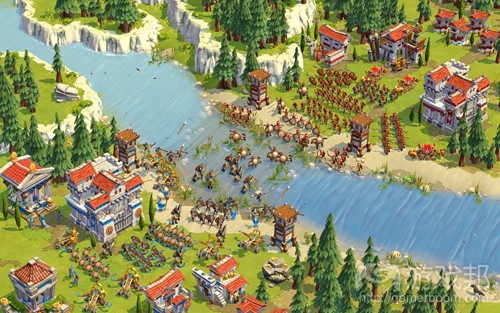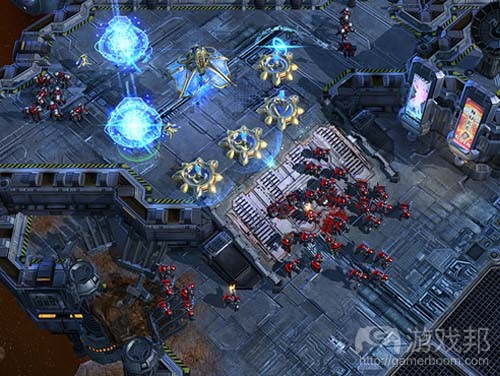阐述个性化的价值及保持游戏平衡性的建议
作者:Josh Bycer
在游戏中,个性化是给予玩家进展和选择的最佳方法之一。允许玩家根据自己喜好创建一个角色或者一支军队,可促进他们与角色的互动,这也是保持他们游戏激情的一大动力。《军团要塞2》所采用的大量道具就是给予游戏重玩价值以及增加游戏寿命的典型之一。随着个性化地流行,更多的设计师也开始在游戏中引进这种元素。
在《暗黑破坏神3》中的5个职业中,每个职业都允许玩家混搭其中的积极和消极技能,允许两个玩家使用同种职业,但是作用却不大相同。在《帝国时代Online》,你可以配备各种可建设的单位,构造不同的武器,也可以把顾问带到提供特定时代加成的战役中。
虽然这些设计从理论上看很棒,但我们在执行这种设计时也要谨慎,以免只见树木不见森林,忽视了游戏中的平衡性问题。在讨论游戏中的平衡以及个性化上,我们需要着眼于两个方面:单人/合作,以及竞争设计。
不可提供无用的选择
设计师在设计合作类游戏时,一般会给予玩家各种各样的选择,并观察这些选择如何在玩家合作(而非相互对抗)过程中取得平衡。我在之前文章中曾提到一个问题:在制作困难的游戏时,有些设计师常会设计出一些无用的选择。
我们观察《暗黑破坏神3》在游戏中段(normal-nightmare)和末段(Inferno)时不难发现这是一款另类的游戏。在Inferno中,许多技能变得完全无效,其生命点降至之前创建时的水平。除此问题之外,由于《暗黑破坏神3》的系统问题,我们很难去判断敌人命值的底线。
由于每一职业的破坏力和防御力取决于其主要属性,无法找到与之相关战利品的玩家就会处于极大的劣势中。但是对于使用拍卖系统的玩家来说,他们只需购买与其职业相关的战利品就能更轻松地驾驭游戏。
还有个问题,就是一个角色拥有过多渗透作用,这导致游戏结局几乎不可能实现平衡。游戏中的五个不同职业都拥有所有技能和符文,加上未使用拍卖系统的玩家所得到的随机战利品,另外游戏还得根据使用拍卖系统的玩家来调节平衡性。因此暴雪在此不仅是搬石头砸自己的脚,甚至可以说是自截下肢。
得益于装备布局和升级系统设置,玩家更容易在《恶魔之魂》中获得平衡感。设计者根据预先设定的装备定位以及视情况而变化的敌人属性,妥善设置了每个阶段的角色属性的基本属性。当然,知道如何让装备和属性发挥更高效能的骨灰级玩家仍会在游戏中遥遥领先,但这并不影响整体游戏平衡性。因为根据少数的硬核群体来平衡游戏,通常只会促成平庸无趣的设计。而你在这种混杂情形中注入竞争元素时,这种设计就更具挑战性了。
竞争角度
平衡性对合作型游戏设计来说非常重要,但对竞争型游戏来说,平衡性设置是否妥当则可能直接决定游戏的生死。高手玩家会不遗余力地试图寻找设计中的一些小瑕疵来获得竞争优势。如果游戏失衡,那么高手玩家就不会触碰这款游戏,游戏也就没有竞争趣味可言了。
对《星际争霸》中的高手玩家来说,平衡性正是游戏大有人气的主要原因之一。设计师不仅平衡了三个非对称的种族,甚至还将每个单位的属性精确到了小数点。从这方面来看,《星际争霸》的设计确值得借鉴。
封闭系统是竞争型游戏实现平衡的关键,这意味着在此等式中没有变量的存在:《星际争霸》中的SCV每次都会以相同的速度收集相同数量的矿石。
问题在于,当设计者赋予玩家自定义战略的能力时,这一等式就相应地出现了变量。如果这些变量总会催生出一个最佳策略,那么骨灰级玩家就会发现并利用它,直到该变量变化为止。对于竞争型游戏而言,玩家的技能水平才是导致成败的首要且关键因素。如果玩家只需通过投入时间或者花钱就可以提升装备的级别,多花数小时就能打败对手,那么竞争型玩家就不会再体验这款游戏了。
战略游戏在数据上更具开放性,所以它更容易分析。对于这些想要在战略游戏中更有竞争力的玩家来说,数字游戏是一项重要的学习工具。在《帝国时代Online》中,可个性化单位的道具和升级奖励很棒,但同时它们也妨碍了游戏实现平衡性。
一个相当好的例子是,一个埃及枪手可以通过升级奖励而变身为冠军战士。这种升级不只提升了它们的属性,也节省了每个单位10个黄金的成本。这意味着,如果某人研究了这项技术,升级了15个枪手之后就可以看到这项研究的回报。如果两个玩家互相对抗,若其中一方没有为自己的文明科技研究进行这类投入,那么他就会处于巨大的劣势。
有了这些道具,它们就会有效地破坏游戏的平衡性。给予原本只够对抗其他同类的弓箭手足够的防御和攻击力,那么它就可以损害任何单位。若是再增加防御能力,即使另外一个对手强大到足以对抗它,那么它比对手多30%的命值也仍是一种战斗优势。
想象下,如果玩家可以在《星际争霸2》开始前选择一些特殊的升级方式:比如所有的Hydralisks都无需花费任何vespane gas成本,那么可想而知游戏系统将严重失衡。
提供个性化体验需要设计师对游戏平衡性高度敏感,以下是一些防止游戏系统失控的小建议:
1. 开闭系统
竞争型游戏应为玩家提供一套学习和创建战略的系统。但这并不意味着设计者不可提供多样性选择。
在《命令与征服:绝命时刻》中:这个扩展内容采用了三个可玩选项,美国、中国和大伦敦政府。每一方都有三个次级派系。每个次级派系都有各自长处,并可根据特定需求而改变战略。例如,选择美国空军可能减少玩家可创建的坦克数量,但却可以让他们建造更多航空单位,并节省这一过程中的成本。
这样玩家就有机会使用特定的派系来改变他们的作战策略,虽然这是一种多样化的设置,但其系统仍具有封闭性,因为玩家无法改变次级军力的设置。最近的《太阳帝国的原罪:起义》也沿用同样方法,把三个种族各分为两个次级派系。每个派系都有不同的加成奖励、单位、科研技术和超级单位。
2.大量的限制条件
未经检验就给予玩家大量与角色有关的选项可能导致游戏失衡,但可以通过添加限制条件来避免这种情况。在《帝国时代3》中,玩家可以在游戏过程中向自己的基地运送资源、额外单位和升级内容。但玩家虽然可以解琐并获取这一切内容,但他们能带入战斗中的东西却有一定的限制。
基于此原因,玩家需要根据自己的文明所需要的策略,创建不同组合的运载物资。你重视的是一个文明的优势 ?还是致力于攻克其薄弱环节?或者想成为万事通?没有哪个玩家可以让自己那方坚不可摧,就像每个运载物资未必都有足够的可安放位置一样。这一点与《帝国时代online》相反,后者允许玩家配置一切更强大武器。这意味着人们玩游戏的时间越长,他们的文明就会越发达。
3. 测试多样化设计
如果不再次提到《军团要塞2》,本文关于个性化的平衡性讨论则无法完整收尾。Valve已经不遗余力地让《军团要塞2》尽量保持一种平衡状态,虽然其中植入了许多我根本数不过来的道具。尽管它过去有些道具设置出现了一些问题,但是Valve已经随着时间发展优化了这些设计。
所谓的“Side Grades”为职业带来了独特的加成,但它们也会带来一些负面因素。要避免任何一个道具成为所有情况中的最佳选项,就要适当减少其损害值,弹药等要素。这种做法的最大好处在于,在《军团要塞2》中投入更多时间的玩家无法轻易打败技能更高超的玩家。无论你使用哪种狙击枪或武器,瞄得准打得狠才是王道。
需要注意的是要让游戏保持平衡性,每个道具都必须在某些方面是一个次级选择。
给予玩家更多玩法选项,似乎是帮助玩家不在游戏中输掉的好办法。但是当游戏出现更多有效变量时,游戏也就有更多内容需要测试。如果开发者希望在过后增加更多的选择或者PvP选项,就要确保游戏根基稳固而不受影响,否则整款游戏就会分崩离析。(本文为游戏邦/gamerboom.com编译,拒绝任何不保留版权的转载,如需转载请联系:游戏邦)
The Price of Personalization
by Josh Bycer
Personalization is one of the best ways of giving players progression and choices in games. Being able to create a character or army to the player’s specification allows them to connect more to their character and is a great motivational mechanic to keep people playing. Team Fortress 2 with its bevy of items is one of the best examples of providing replay-ability and longevity to a game. Because of the popularity of personalization, more designers are experimenting with it in their designs.
With Diablo 3, players can mix and match active and passive skills for each of the five classes, allowing two players using the same class, to be very different in terms of utility. While in Age of Empires Online, you can equip every build-able unit and structure with a variety of gear and take advisers into battle that provide age specific bonuses.
While all this looks great on paper, personalization needs to be kept in check as we’re seeing cases where designers are not able to see the forest for the trees with balance. To talk about game balance and personalization, there are two areas we need to focus on: single-player/cooperative, and competitive design.
The False Choice Syndrome:
Cooperative design is where designers like to give players a variety of choices, seeing as how they can design and balance them around player’s working together (or solo) instead of using them against each other. The problem which I talked about in my post about the difference between masochism and challenge in design: Is when to make a game difficult, the designers make some choices useless.
Diablo 3 is a different game when we look at the early to mid game (normal-nightmare) vs. the end game (inferno.) As it stands, many skills outright become ineffective for inferno, reducing survivability down to a number of pre-defined builds. Compounding this issue is that it’s hard to determine base-lines for enemy values due to Diablo 3′s system.
Because of how the primary attribute for each class dictates damage and defense, players who aren’t able to find loot related to it will have a huge disadvantage. But for people who use the auction house system, they can render the game a lot easier by just buying the best loot related to their class.
The problem is that there are so many permeations to a character, that it makes the end game near impossible to balance. They have 5 different classes with all the skills and runes, plus randomized loot for people who don’t use the auction system, and then they have to adjust for people who did use it. Blizzard didn’t just shoot themselves in the foot; they took a chainsaw and chopped it off.
In Demon’s Souls, game balance was far easier to achieve due to equipment placement and the leveling system. The designers had a good idea of what would be the base line attributes of a character at each stage of the game thanks to pre-defined equipment locations and altered enemy attributes accordingly. Of course, expert players who knew how to get every little bit of power out of their equipment and attributes could blaze through the game, but that’s alright. As balancing a game around the hardcore minority usually leads to boring design. This becomes even more challenging when you throw competition into the mix.
The Competitive Angle:
While balance is important for cooperative design, competitive games live or die based on how balanced they are. Gamers who play professionally will comb over every inch of the game’s design to find any little tricks or issues with the design for an advantage. If the game is not balanced, professional gamers will not touch it and the competitive scene will die.
The importance of balance is one of the main reasons behind the popularity of Starcraft on the professional scene. Not only did the designers balance 3 asymmetrical races, but they fine tuned them down to the decimal point of every unit’s attributes. Starcraft’s design is one of those games that deserve to be studied on this fact alone.
The detail that makes balance achievable in competitive games is a closed system. This means that there are no variables to the equation: a SCV in Starcraft will move and gather the same amount of minerals at the same rate every-time, no questions asked.
What happens is that when designers add the ability for the player to personalize their strategies, it adds variables to the equation. If any one of those variables leads to an always optimal strategy, a professional gamer will find it and exploit it until it is changed. For a game to be considered competitive, the gamers’ skill has to be first and foremost the factor in winning or losing. If someone can just equip better gear through time or money and can beat someone with several more hours at the game, no competitive gamer will want to play.
Strategy games in particular are easy to analyze due to how open they are in terms of numbers. The numbers game becomes an important learning tool for anyone who wants to be competitive at a strategy game. In Age of Empires Online the variety of items and premium upgrades that can personalize units is great, but they get in the way of providing balance.
Case in point: An Egyptian Spear-man can be upgraded to a champion via a premium upgrade. This upgrade not only increases the attributes of them, but removes the gold cost which is normally 10 per unit. What that means is that if someone researches it, after 15 spear-men the research has paid for itself. This is a huge deal and major advantage if two players are against each other and one hasn’t spent money on their civilization, then that player has a huge disadvantage.
With items, they can effectively break the balance of the game. Giving an archer unit enough defense and offense can make something that is only supposed to be effective against archers, now able to hurt everything. Combined with defense, even if another unit is strong against it, having 30% more health can be a huge deciding factor.
Imagine if players could choose special upgrades in Starcraft 2 before the match began: such as all Hydralisks have 0 vespane gas cost, and picture how bad the balance would be ruined with that.
Providing ways of personalizing the experience requires a careful eye for balance, and there are some tips designers can follow to prevent things from getting out of control.
1. An Open-Closed System:
Competitive games as mentioned require a set system for players to learn and build their strategies around. But that doesn’t mean a designer can’t give some leeway with variety.
In Command and Conquer Generals: Zero Hour, the expansion took the three playable sides: US, China and GLA and gave each one, three sub factions. Each sub faction took their respective side and altered it to emphasize a specific strategy. For example, the US air general removed the majority of tanks a player could build, but gave them more air units and made them cheaper in the process.
This gave gamers a chance to use these specific factions to alter their strategy during vs. but even though this introduced variety, the system was still closed as the player could not alter the sub factions. Recently Sins of A Solar Empire: Rebellion went a similar route, splitting each of the three races into 2 sub factions. Each one had different bonuses, units, researches and a super unit they could build.
2. A Variety of Limits:
Giving players multiple ways of affecting their character may lead to imbalance if left unchecked, but it can be reign in by providing limits. In Age of Empires 3, players had shipments in the form of resources, additional units, and upgrades that could be sent to their base during play. However, while the player can eventually unlock access to all of them through playing online, there is a limit of how many they can take into a match.
Because of that, it allowed players to create “decks” of different shipments built around different strategies for their civilization. Do you focus on the strengths of a civilization? Or work to counter their weakness? Or go for a jack of all trades route? No one could make their side unbeatable, as there weren’t enough slots available to fit every shipment in. Contrast to Age of Empires Online where players can equip everything with better gear. Meaning that the longer someone plays, the better their Civilization will naturally get.
3. A Side Order of Balance:
A discussion of personalization balance cannot be complete without another mention of Team Fortress 2. Valve has gone to great lengths to keep Team Fortress 2 as balanced as possible, even with more items then I can count. In the past there have been a few items that did slip through the cracks (the original medic hack saw upgrade for example,) but Valve has improved over time.
“Side-Grades” as they are called, provide unique bonuses to the classes, but they also come with a negative factor as well. From reduced damage, less ammo and many, many more are factored in to prevent any one item from being the optimal choice for all situations. The best part is that this prevents having more time spent playing Team Fortress 2, to beat out people with greater skill. It doesn’t matter what sniper rifle you’re using if you can’t aim accurately.
What’s important to remember is that for this to work properly, every item has to be a side-grade in some way or another. As having an item that beats everything else, defeats the purpose of the side-grade system.
Giving players more options of how to play the game always seems like a no-lose solution, but the more variations available, means more areas that need to be tested. If the developer wants to add more choices or even the option for PvP at a later date, they need to make sure that the foundation of the game is steady, or the whole thing could fall apart.(source:gamasutra)









































 闽公网安备35020302001549号
闽公网安备35020302001549号